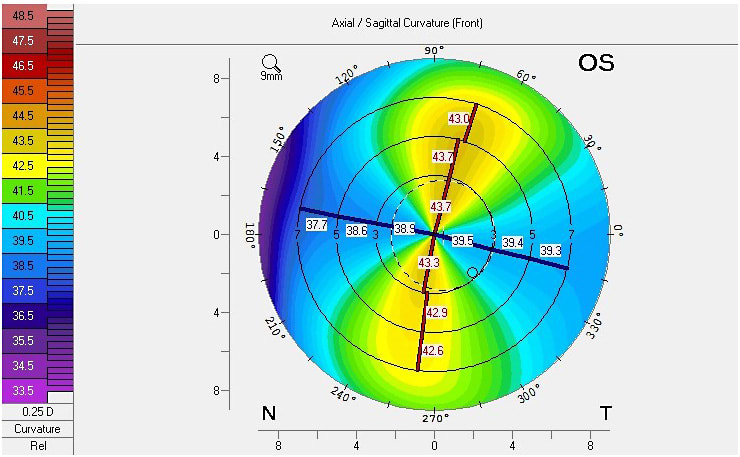When an astigmat begins to experience a decrease in near and intermediate visual acuity and is entering presbyopia, previously successful contact lens (CL) designs may no longer be ideal. The following reviews some currently available presbyopia CL design modalities for astigmatism.
Monovision With monovision, the dominant eye is corrected for distance vision while the nondominant eye is corrected for near or intermediate. Monovision is advantageous because patients can continue wearing the same toric CL brand to which they are accustomed.
Soft Toric Multifocals Ideal candidates for soft toric multifocals are patients who may have been previously successful with a toric soft CL, are dissatisfied with monovision, or are motivated to limit the use of reading glasses. They are available in either center-distance or -near designs. Advances in lens materials have resulted in increased popularity of custom soft multifocals for astigmatism. Clinicians can also customize base curve, diameter, lens power (sphere, cylinder/axis, and add power), center-distance or -near, and optic zone size.
GP Multifocals These lenses may be ideal for patients who have critical vision needs, are dissatisfied soft toric multifocal lens wearers, or who have higher levels of astigmatism. GP multifocal lenses are available in aspheric, translating, and scleral lens designs.
For aspheric lenses, add power is produced by a gradual change in curvature. Traditionally, add powers were limited to the back surface and were not ideal for astigmats; now, add power changes can be on the front surface as well. This is good for patients who have higher levels of corneal astigmatism (> 2.00D) who may require a back-toric design for improved stability and comfort.
Translating corneal GP bifocals and trifocals contain one or two segments, respectively, that provide excellent vision for intermediate and near demands. A patient’s lid position and gaze help to properly position the reading segment in front of the pupil. These designs are ideal for patients who have low-to-moderate levels of astigmatism.
Scleral multifocals are available for patients who prefer the crisp vision of a corneal GP lens combined with the comfort of a scleral. These are available for astigmatism in both center-distance or -near designs, with the ability to modify optical zone size and location.
Case Report
A 46-year-old female presented with a complaint of blurred vision at near. She was previously a successful bitoric GP wearer but had not worn them regularly for the past several months. Manifest refraction was OD +3.25 –5.75 x 015 (20/20) and OS +3.75 –5.25 x 167 (20/20). Corneal topography was OD 39.7/44.1 @ 104 (Figure 1A) and OS 39.2/43.5 @ 075 (Figure 1B).


She was fit with aspheric GP multifocals: OD 7.98mm/7.35mm base curve (BC), 9.40mm diameter; –0.12D/–3.75D power, +1.75D add (Figure 2A) and OS 8.08mm/7.45mm BC, 9.40mm diameter; +0.75D/–2.75D power, +1.75D add (Figure 2B).


Visual acuity was 20/20 at distance and 20/25 at near. She was happy with her distance, intermediate, and near vision as well as with the comfort and fit, and she enjoyed not needing to use reading glasses. CLS




